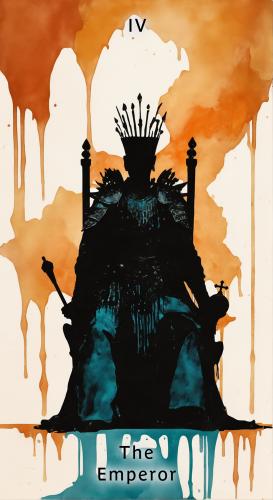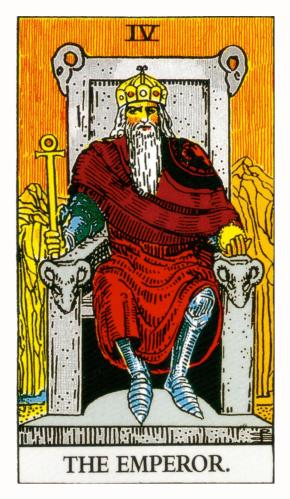Personal Reflections
Have you ever found yourself promoted to a position of authority and wondered if the universe was playing a cosmic practical joke? The Emperor card often pops up when we're called to step into our power, even if we feel more like a court jester than a ruler.
Take Sarah, a client who drew the Emperor when asking about her new role as a team leader. She was terrified of making decisions that would affect others, imagining herself as a bumbling sitcom boss, complete with awkward silences and coffee-stained shirts. We chuckled about her fear of accidentally starting a workplace revolution with a misplaced memo.
But here's the thing: the Emperor isn't about being perfect. It's about creating a structure where everyone can thrive. Sarah learned to see leadership as a form of service, providing the stability and direction her team needed to succeed. She started small, organizing team meetings that didn't feel like medieval torture sessions and setting clear expectations that didn't require a decoder ring to understand. Gradually, she found her footing, realizing that leadership wasn't about having all the answers, but about asking the right questions and empowering others to find solutions.
The Emperor also embodies the archetype of the father figure, offering guidance, protection, and mentorship. It reminds us that true leadership involves nurturing the potential in others, much like a parent encouraging a child to stand on their own two feet.
Now, let's flip this crown upside down for a moment. The reversed Emperor isn't just about being a micromanaging boss who thinks "delegation" is a dirty word. Sometimes, it's about our struggle with authority itself, often rooted in our relationship with the first authority figures we ever knew: our parents.
I once worked with Alex, who drew the reversed Emperor during a career reading. Alex had been jumping from job to job, never quite finding satisfaction. As we dug deeper, it became clear that Alex was subconsciously rebelling against their father's expectation of following a traditional career path. Every time Alex started to establish themselves in a job, that rebellious streak would kick in, sabotaging their progress.
It was like Alex was playing a never-ending game of career whack-a-mole, with their inner teenager wielding the mallet. "Take that, societal expectations!" whack "And that, Dad's disapproving voice in my head!" whack The result? A professional life that felt as stable as a house of cards in a wind tunnel.
We explored how Alex could assert their independence without setting fire to every bridge they crossed. It turned out that forging their own path didn't mean they had to be in constant opposition to authority or tradition. Alex started to see how they could blend their innovative ideas with established structures, creating a career that was uniquely theirs without needing to rebel at every turn.
The Emperor, upright or reversed, reminds us that authority - whether wielding it or dealing with it - is a delicate balance. It's about creating a framework sturdy enough to support growth, yet flexible enough to adapt to change. It's knowing when to stand firm and when to bend, when to follow the rules and when to rewrite them.
So the next time you need to channel your inner Emperor, remember: a sense of humor can be as valuable as that fancy scepter. Whether you're calling the shots or finding your place within the hierarchy, don't forget to laugh at the absurdity of it all occasionally. After all, even emperors need to chuckle at themselves now and then – especially when they realize they've been wearing their crown backwards all day.
Symbolism
- Ram's heads: Symbolize determination and connection to Aries
- Ankh scepter: Represents life and authority
- Orb: Signifies worldly power and control
- Mountains: Indicate stability and challenges to overcome
- Red robe: Symbolizes passion and energy
- Armor: Represents protection and preparedness
Historical Background
The Emperor has roots in the figure of the ruler or king in ancient tarot decks. In early Italian tarot, he was often depicted as the Holy Roman Emperor. Over time, the card evolved to represent not just literal rulers, but the concepts of authority, structure, worldly power, and fatherhood in general. The Emperor is often seen as a counterpart to The Empress, representing the paternal principle as she represents the maternal.
Pairings
- The Emperor + The Empress: Balance between structure and nurturing
- The Emperor + The Hierophant: Focus on traditional values or institutions
- The Emperor + The Tower: Disruption of established structures or authority
- The Emperor + The Chariot: Strong leadership and determination in pursuing goals
- The Emperor + The Hermit: Wisdom in leadership, or a need to reflect on one's use of power
Be Aware of...
- The querent's relationship with authority figures, especially father figures
- Areas in the querent's life lacking structure or discipline
- Potential need for the querent to assert their independence
- Possible resistance to necessary rules or structures
- Overreliance on logic at the expense of emotion or intuition
- The role of passion and drive in the querent's situation
- Issues related to mentorship or guidance, either giving or receiving
Exercises and Meditations
- In what areas of my life do I need to establish more structure or take more control?
- How can I balance being a strong leader with remaining open to others' ideas?
- What does healthy authority look like to me, and how can I embody it?
- Where in my life might I be too rigid, and how can I introduce more flexibility?
- How does my relationship with my father (or father figure) influence my own leadership style?
- In what ways can I assert my independence while still maintaining important relationships?
- What passions drive me, and how can I harness them to achieve my goals?
Comments are not enabled for this post yet







